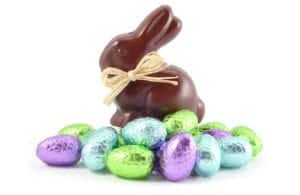
All about Chocolate!
In honour of Easter, what better topic to write about than chocolate? Did you know that the average Canadian consumes about 12 pounds of chocolate per year? That is a lot of chocolate; but not compared to the Swiss, with the world’s largest chocolate consumption at a staggering 22 pounds per person per year! Needless to say, chocolate is enjoyed by many around the world.
DYK that the average Canadian consumes about 12 pounds of chocolate per year? Share on XDo you have a favourite type of chocolate? Are you a fan of the traditional milk chocolate, or do you opt for the creamy white chocolate, or maybe you reach for the bar of bitter dark chocolate? Today, we will take a closer look at this classic confectionary to clarify common areas of uncertainty.
Chocolate for Health:
Chocolate is derived from cocoa beans, which contain a type of plant-based antioxidant called flavonoids. Research is showing possible heart health and cancer benefits when we consume foods rich in flavonoids (such as fruits, vegetables, nuts, seeds, tea, wine). Further research is still needed to determine specific amounts to consume for health benefits, but the positive impact is possibly attributed to the antioxidant effect on improving blood flow and making blood platelets less prone to clotting.
In cocoa’s natural form (unprocessed) it has a very strong, pungent taste, which comes from the flavanols. However, when cocoa is processed into a variety of chocolate products, it goes through several steps (fermenting, alkalizing, roasting, etc.) to reduce this bitter taste. Therefore, the more chocolate is processed, the more flavanols are lost.
What does the Cocoa Percentage Mean?
On many chocolate packages you will notice manufacturers including a percentage of cocoa. This percentage indicates the amount, by weight, of all ingredients derived from the cocoa bean. Therefore, this number reveals the total percentage of cocoa solids (chocolate liquor or cocoa powder) and cocoa butter. The cocoa solids give flavour, and the cocoa butter gives the smooth texture. A higher percentage means more actual chocolate and less added ingredients like sugar. However, a higher cocoa percentage does not necessarily equate to added health benefits since it does not indicate the ratio of the cocoa butter to the bitter tasting cocoa solids.
Fat in Chocolate:
The fat in chocolate comes from cocoa butter and is made up of equal amounts of oleic acid (heart-healthy monounsaturated fat found in olive oil), stearic acid and palmitic acids. Stearic and palmitic acids are forms of saturated fat, which has notoriously been linked to bad cholesterol and increased risk of heart disease. However, research is now showing that stearic acid may not be as bad as we once thought with research showing possibly neutral effect on cholesterol. The cholesterol story is still incomplete but it is safe to say that this type of saturated fat may not be as bad as we once thought. Still, be mindful of portions since chocolate remains high in calories, especially when consumed in large amounts.
Is White Chocolate really Chocolate?
White chocolate technically is not chocolate. This is because white chocolate contains no cocoa solids (they are removed) leaving only cocoa butter to be combined with milk, sugar, emulsifiers and vanilla. The majority of the flavanoids are from the cocoa solids so white chocolate is not associated with health benefits.
The flavanoids are from cocoa solids, so white chocolate isn't associated with health benefits. Share on XIs Dark chocolate the Healthiest?
The short answer is yes. Generally, dark chocolate is the least processed and with the highest levels of flavonoids from the cocoa solids. Dark chocolate usually has a high cocoa percentages ranging from 70 to 99 percent.
Bottom Line:
Don’t feel guilty enjoying a small piece of dark chocolate; there appears to be potential cardiovascular benefits. Moderation is still key, aim for 1-ounce servings a few times per week. Also be sure to enjoy other flavonoid-rich foods like fruits, vegetables, nuts and tea.
Happy Easter!




